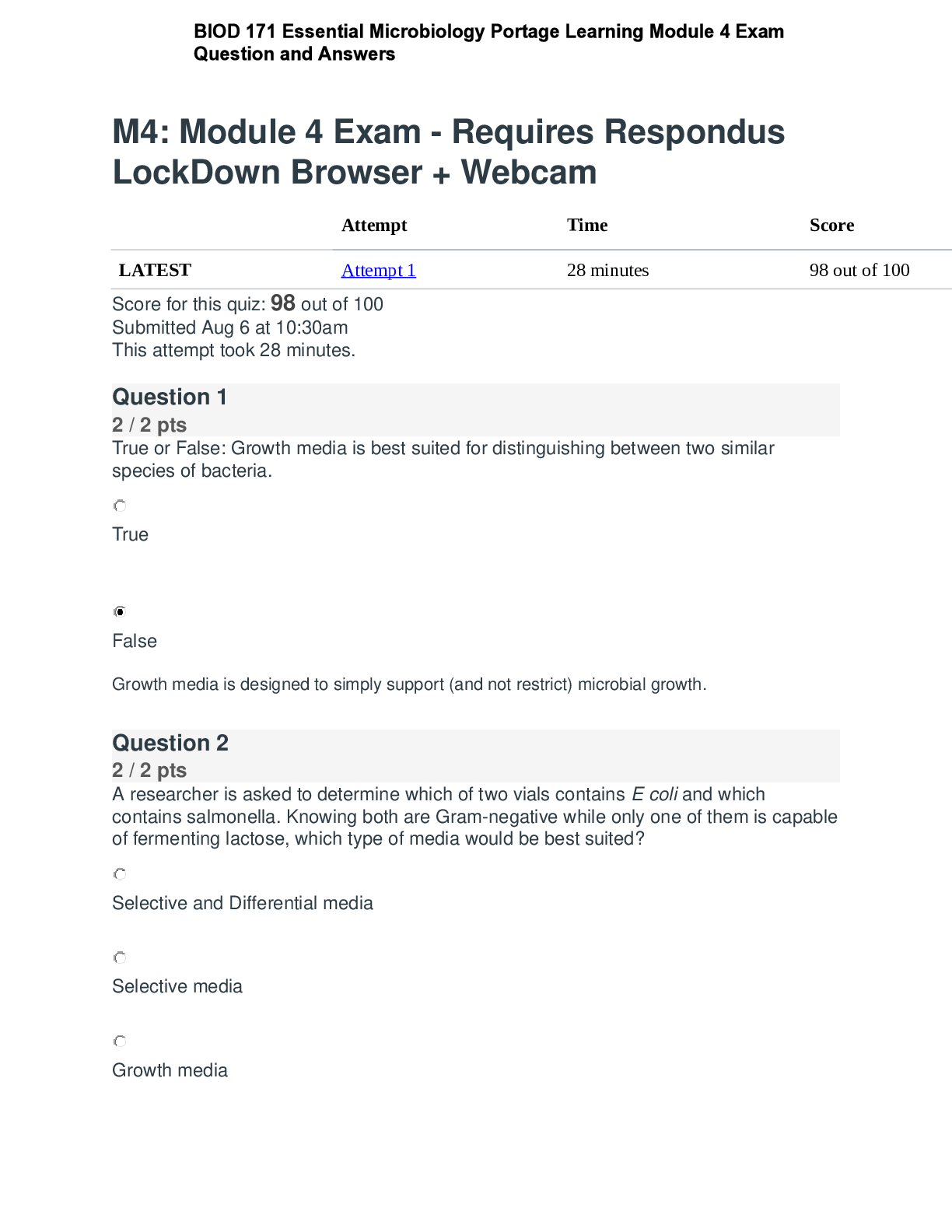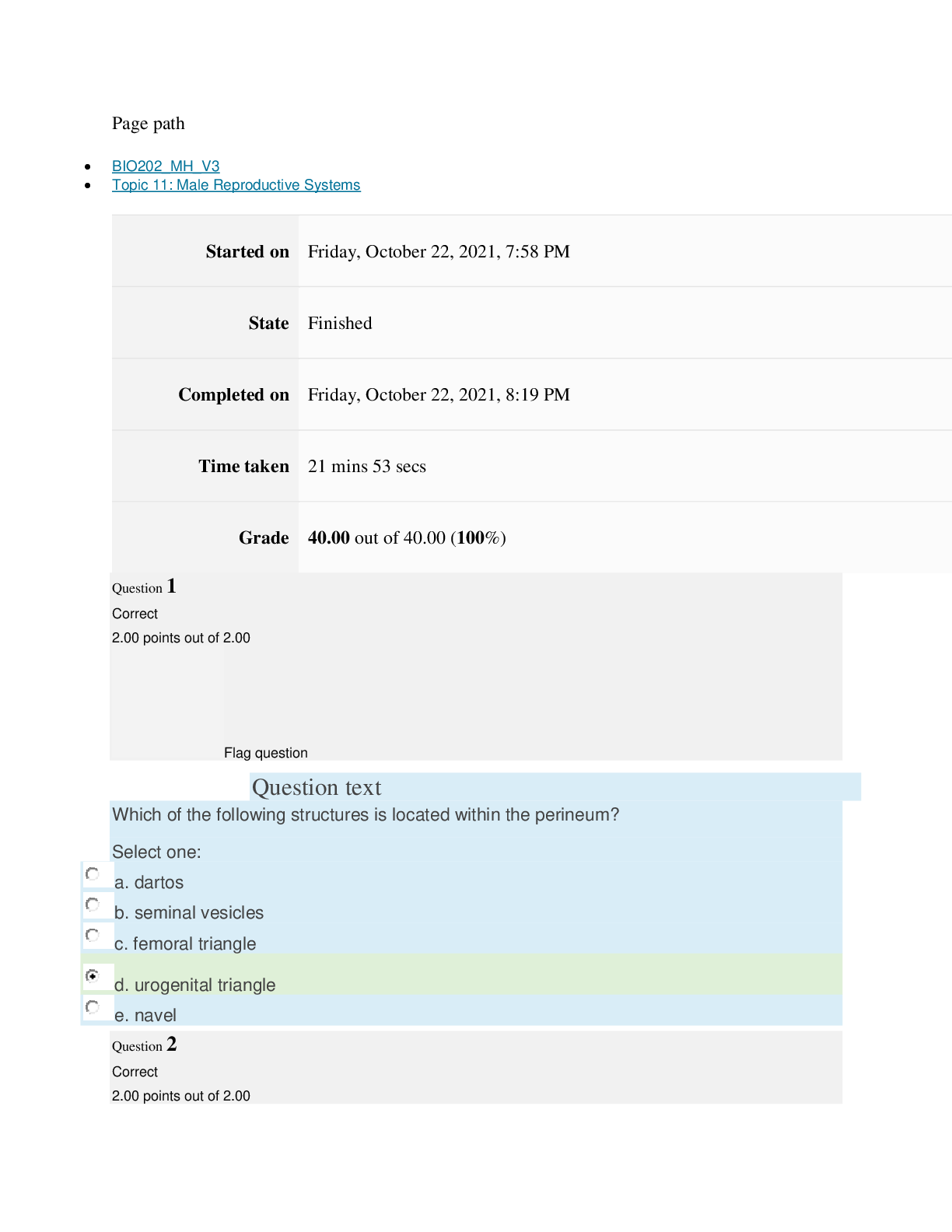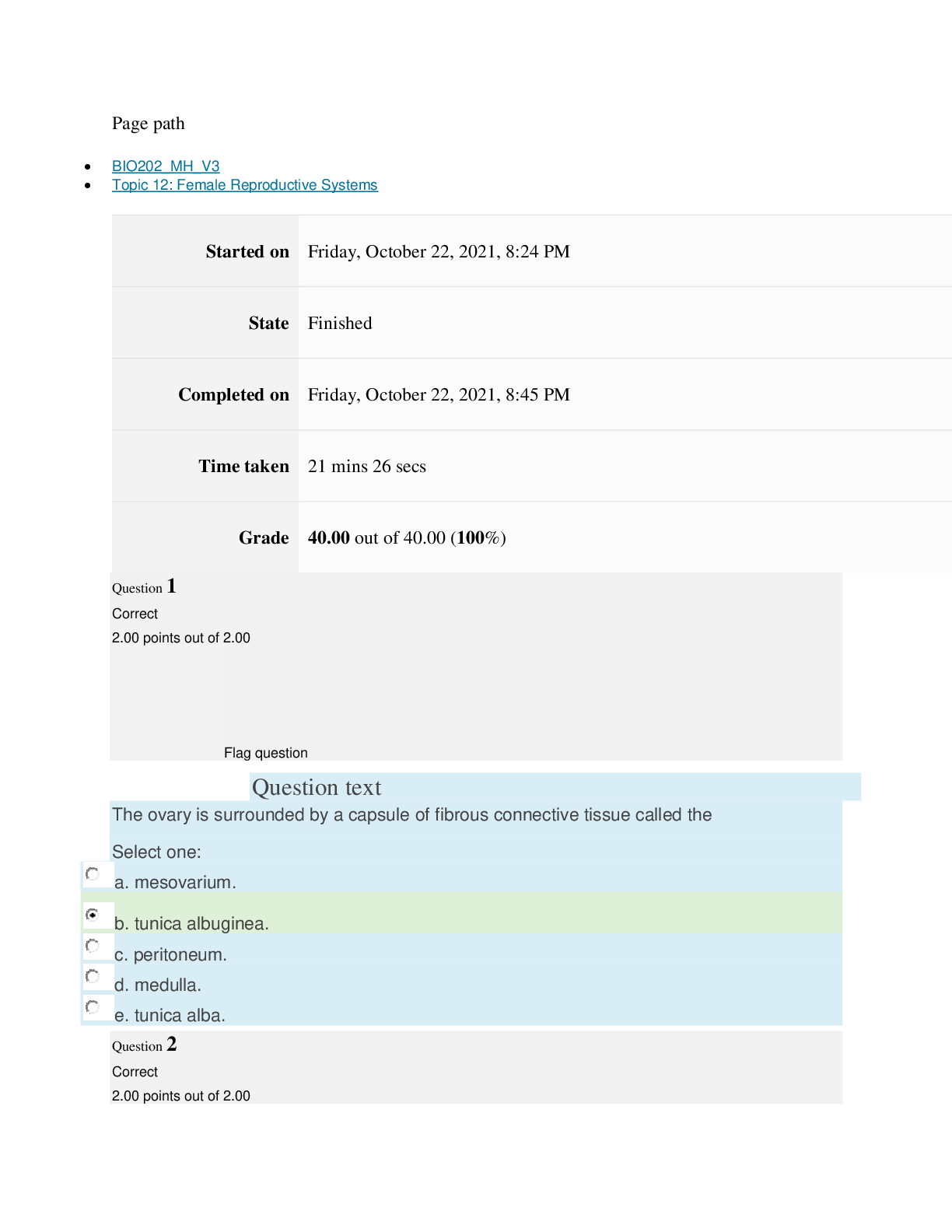Food and Nutrition > QUESTIONS & ANSWERS > Test Bank Scientific American: Nutrition for a Changing World Chapter 16 Fitness and Sports Nutritio (All)
Test Bank Scientific American: Nutrition for a Changing World Chapter 16 Fitness and Sports Nutrition Multiple-Choice Questions (Already Graded A+)
Document Content and Description Below
1. Which is not a benefit of regular physical activity? A. improves immune function B. reduces risk of colon and breast cancer C. reduces risk type 1 diabetes D. strengthens bones E. reduces risk... of cardiovascular disease Answer: C Type: Application Difficulty: Medium Learning Objective: Identify five health-related benefits of regular physical activity (Infographic 16.1) Keywords: exercise, health benefits, physical activity 2. Which is an example of resistance exercise? A. ice skating B. long-distance running C. yoga D. biking E. weight lifting Answer: E Type: Application Difficulty: Medium Learning Objective: Describe the four components of physical fitness (Infographic 16.2) Keywords: physical fitness, resistance exercise, strength training 3. Which is an example of neuromotor exercise? A. ice skating B. long-distance running C. yoga D. biking E. weight lifting Answer: C Type: Application Difficulty: Medium Learning Objective: Describe the four components of physical fitness (Infographic 16.2) Keywords: physical fitness, balance, coordination, agility 4. Which type of exercise improves cardiovascular fitness? A. stretching B. resistance exercise C. yoga D. uphill biking E. weight lifting Answer: D Type: Application Difficulty: Medium Learning Objective: Describe the four components of physical fitness (Infographic 16.2) Keywords: physical fitness, endurance, cardiovascular health, maximal heart rate 5. Which list shows energy systems in the correct order of fastest to slowest rate of ATP production? A. glycolysis, glucose oxidation, fat oxidation, phosphagen B. glucose oxidation, phosphagen, glycolysis, fat oxidation C. fat oxidation, glucose oxidation, glycolysis, phosphagen D. phosphagen, glycolysis, glucose oxidation, fat oxidation E. glycolysis, fat oxidation, glucose oxidation, phosphagen Answer: D Type: Analysis Difficulty: Medium Learning Objectives: Identify the components of the anaerobic and aerobic energy systems and rank these four components according to the rate at which they produce adenosine triphosphate (ATP) (Infographic 16.3) Keywords: ATP, energy systems, exercise duration 6. Where in the cell do anaerobic energy systems produce ATP? A. mitochondria B. cytosol C. nucleus D. endoplasmic reticulum E. plasma membrane Answer: B Type: Comprehension Difficulty: Medium Learning Objectives: Identify the components of the anaerobic and aerobic energy systems and rank these four components according to the rate at which they produce adenosine triphosphate (ATP) (Infographic 16.3) Keywords: ATP, cytosol, anaerobic energy systems 7. Where in the cell do aerobic energy systems produce ATP? A. mitochondria B. cytosol C. nucleus D. endoplasmic reticulum E. plasma membrane Answer: A Type: Comprehension Difficulty: Medium Learning Objectives: Identify the components of the anaerobic and aerobic energy systems and rank these four components according to the rate at which they produce adenosine triphosphate (ATP) (Infographic 16.3) Keywords: ATP, mitochondria, oxygen, aerobic energy systems 8. Anaerobic glycolysis produces A. glycogen. B. lactate. C. creatine phosphate. D. creatine monohydrate. E. glucose. Answer: B Type: Comprehension Difficulty: Medium Concept: Energy system fuels (Infographic 16.4) Keywords: lactate, lactic acid, anaerobic glycolysis 9. Glycogen is stored in the A. heart and skeletal muscles. B. liver and adipose tissue. C. liver and skeletal muscles. D. brain and heart. E. heart and kidneys. Answer: C Type: Comprehension Difficulty: Medium Concept: Energy storage Keywords: glycogen, carbohydrate storage 10. The major factor leading to exhaustion during exercise is A. lactic acid build-up. B. depletion of muscle glycogen. C. iron deficiency anemia. D. depletion of muscle protein. E. insufficient vitamin B12. Answer: B Type: Analysis Difficulty: Medium Learning Objective: Explain why adequate dietary carbohydrates are necessary for endurance training to be effective (Infographics 16.8 and 16.10) Keywords: glycogen, dietary carbohydrates, fatigue, carbohydrate loading 11. Nutritional ergogenic aids are A. substances believed to promote weight loss. B. substances believed to improve athletic performance. C. substances believed to reduce disease risk. D. substances believed to enhance academic performance. E. All of the above. Answer: B Type: Comprehension Difficulty: Easy Concept: Nutritional ergogenic aids Keywords: athletic performance, sports supplements 12. Which is NOT an example of a nutritional ergogenic aid? A. amino acid supplements B. creatine monohydrate C. water D. whey protein powder E. caffeine Answer: C Type: Application Difficulty: Medium Concept: Nutritional ergogenic aids Keywords: athletic performance, sports supplements 13. Which is NOT a component of the female athlete triad? A. amenorrhea B. bone loss (osteoporosis) C. energy restriction D. iron deficiency anemia E. anorexia nervosa or bulimia nervosa Answer: D Type: Comprehension Difficulty: Medium Concept: Nutritional concerns of athletes Keywords: amenorrhea, bone loss, energy restriction, female athlete triad 14. What is the major fuel used during low-intensity activity? A. fat B. carbohydrates C. proteins D. lactate E. creatine phosphate Answer: A Type: Analysis Difficulty: Medium Learning Objective: Describe how exercise intensity and duration affects the use of carbohydrates and fat as fuel (Infographics 16.5 and 16.6) Keywords: fuel sources, exercise duration, low-intensity exercise [Show More]
Last updated: 1 year ago
Preview 1 out of 15 pages
.png)
Buy this document to get the full access instantly
Instant Download Access after purchase
Add to cartInstant download
We Accept:

Reviews( 0 )
$12.50
Document information
Connected school, study & course
About the document
Uploaded On
Sep 09, 2021
Number of pages
15
Written in
Additional information
This document has been written for:
Uploaded
Sep 09, 2021
Downloads
0
Views
71
.png)

.png)
.png)
.png)
.png)
.png)
.png)
.png)
.png)
.png)
.png)
.png)

.png)
.png)
.png)
.png)




